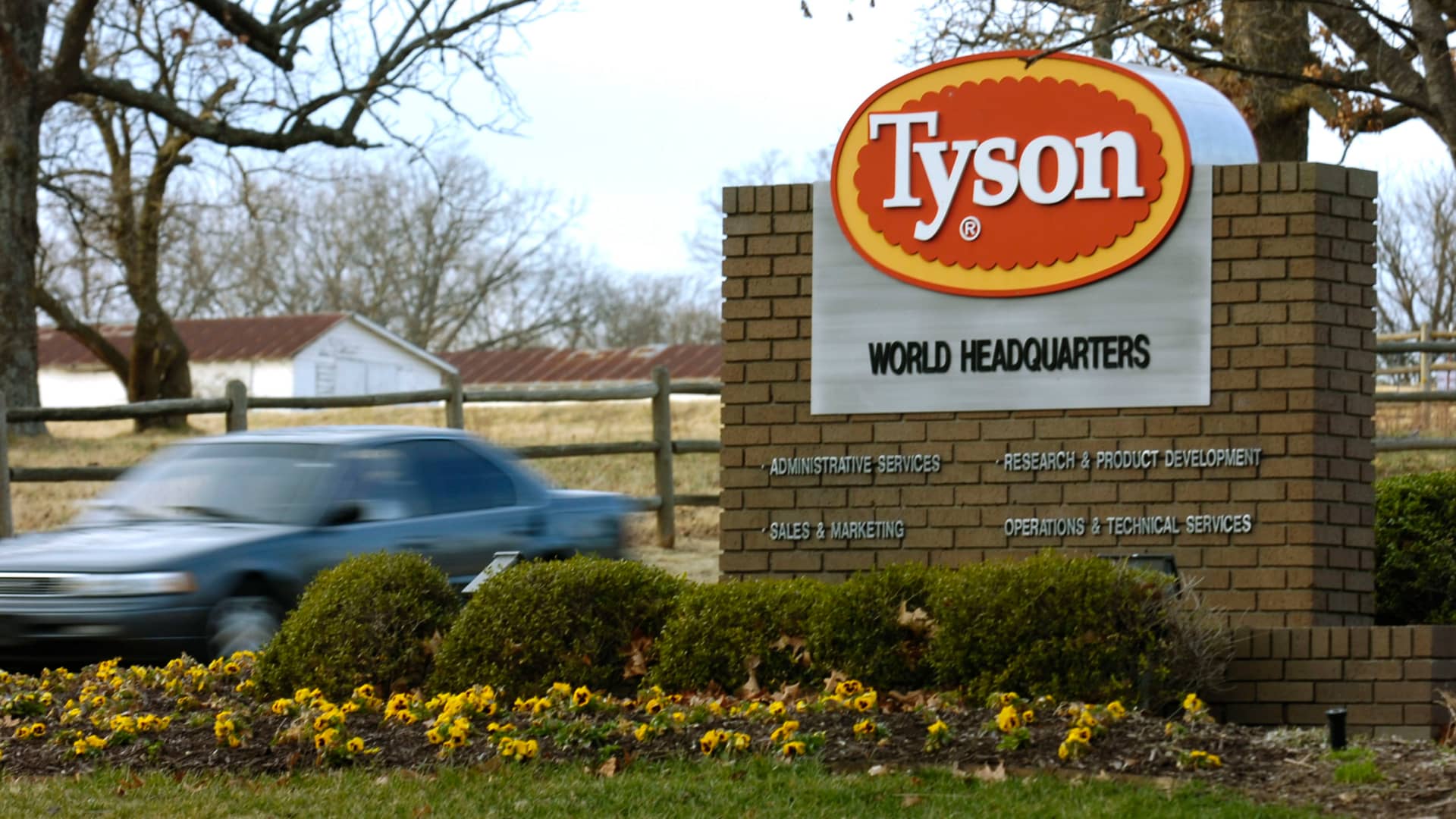
Tyson Foods Inc., sign at Tyson headquarters in Springdale, Ark.
April L. Brown | AP
Tyson Foods will become one of the first Fortune 100 companies to stop using the nation’s traditional large pharmacy benefits managers, as it looks to cut spending on high-cost drugs.
After putting its benefits contract up for bid, Tyson dropped CVS Health‘s Caremark and chose PBM startup Rightway to manage drug benefits for its 140,000 employees starting this year, the companies said Wednesday. Rightway guarantees it can save employers 15% on pharmacy costs by using a transparent model where it passes drug discounts to employers and plan members, while also providing concierge care to help employees find lower-cost alternatives like generics and biosimilars.
Tyson’s decision adds to an upheaval in the industry, as startups promising lower costs and transparency challenge the largest benefit managers, and pushed them to change their own business models. Tyson made the decision as it saw pharmacy costs soar.
“We were going anywhere between 12% to 14% increases for pharmacy — and on a $200 million spend that’s quite a bit. We found that the specialty (drug) component of our trends … were picking up a lot of the increase year over year,” said Renu Chhabra, Tyson vice president and head of global benefits.
When she tried to get answers on what was driving those trends from the company’s old pharmacy benefit manger, or PBM, Chhabra says she couldn’t get the kind of data she wanted.
“I wanted to look at Humira, and I wanted to see what the acquisition cost was. And then I wanted to understand what Tyson was paying for that; it was very difficult to get to those numbers,” she said. “Part of this was to really get a partner who can help us organize the information, make sure we understand how to manage specialty, and really looking at how to get the best net cost.”
Choosing a transparent PBM startup
Most large employers work with the three biggest PBM players: CVS‘ Caremark, Cigna’s Evernorth and UnitedHealth Group’s OptumRx. By the end of 2022, those big three PBMs controlled nearly 80% of the pharmacy benefits market in the U.S., according to a Health Industries Research Center report.
The large players contend that they have the scale to save employers on drugs costs, by negotiating big rebates from drugmakers. But they have come under increasing scrutiny from Congress and regulators at the Federal Trade Commission over the lack of transparency into the way they negotiate those discounts, and how much of those savings they actually pass on to employers and patients.
Smaller PBMs like Rightway have marketed themselves as more transparent alternatives, without the conflicts of interest that the more vertically integrated players have.
“The traditional PBM model has operated on a taxi-meter type approach. The more drugs that your members are on, the higher cost drugs that your members are receiving, the more money PBMs have made or are making,” said Rightway co-founder and CEO Jordan Feldman. “We wanted to fundamentally re-architect what it meant to be a PBM … we don’t trap margin because we don’t retain rebates.”
New competition in the industry
Until now, the upstarts challenging the big PBMs have only won over small and medium-sized companies. Tyson is Rightway’s first employer with more than 100,000 workers; its previous biggest client had 10,000 employees.
University of Southern California economist Karen Van Nuys said if more large employers turn to alternatives PBM players, it could improve competition and bring costs down.
“If they’re presented with a broader variety of transparent options where they can actually kind of see and compare … across different PBM providers what it’s going to cost them — I think that enables all of them to make better decisions about which provider to use,” said Van Nuys, a senior fellow at the USC Schaeffer Center for Health Policy and Economics.
But Lawton Robert Burns, a professor at the University of Pennsylvania’s Wharton School, is not convinced that the movement toward greater price transparency will be a magic bullet that brings down drug prices.
“They’ve undertaken a lot of competitive strategies to try to deal with this. So, they’re responsive,” Burns said. “Whether or not that’s going to make a huge difference, I don’t know. All I know is that price transparency, in general, just hasn’t solved many of our problems.”
At Tyson, the biggest health problem it hopes to tackle in the year ahead with its new PBM is diabetes management, and finding the right balance when it comes to coverage for GLP-1, or glucagon-like peptide-1, weight loss drugs like Wegovy and Zepbound, which carry a list price of more than $1,000 per month.
“In June we’ll make those decisions on how we want to treat that, but we have to balance cost with access to care,” said Chhabra. “This is one of the biggest reasons why we also chose Rightway — because we have a lot more flexibility … going forward to make those joint decisions.”
Don’t miss these stories from CNBC PRO:
Read More: World News | Entertainment News | Celeb News
CNBC








